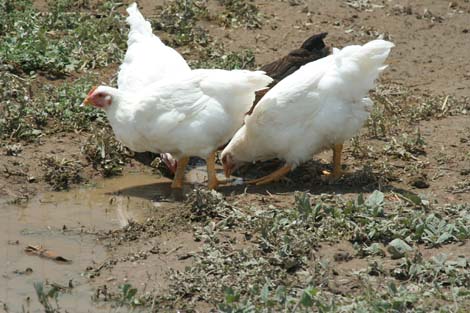 Seriously. Read the title again and decide if you want to continue. Today’s post will detail the processing of our fryer chicks, so named because that’s what we intend to do with them. (Well, maybe roast in our case.) When my husband announced that we would be processing our own chickens, my first response was, “No. No. No.” My second response was, “No. Everyone who does that vows never to do it again. No.” However, he wasn’t so much asking me as telling me that’s what we were going to do. We take all our steers and pigs to a state inspected facility but no such facility exists in our area for chickens. Nate’s brother Matt (a Utah State University Extension Agent) assured us it could be done. We’d do our chickens and their chickens on the same day and help each other. Oh boy, twice the fun.
Seriously. Read the title again and decide if you want to continue. Today’s post will detail the processing of our fryer chicks, so named because that’s what we intend to do with them. (Well, maybe roast in our case.) When my husband announced that we would be processing our own chickens, my first response was, “No. No. No.” My second response was, “No. Everyone who does that vows never to do it again. No.” However, he wasn’t so much asking me as telling me that’s what we were going to do. We take all our steers and pigs to a state inspected facility but no such facility exists in our area for chickens. Nate’s brother Matt (a Utah State University Extension Agent) assured us it could be done. We’d do our chickens and their chickens on the same day and help each other. Oh boy, twice the fun.
As last Thursday, the scheduled processing day, loomed closer, Nate assured me it wouldn’t be as bad as everyone said. He explained we would be skinning the chickens and not using boiling water water to remove feathers. I was still nervous about the whole “chicken running around with its head cut off” scenario due to numerous retellings of my mom’s childhood experiences.
Their family raised chickens one year. When it came time to butcher them, my 5’2″ Grandmother took the butcher knife out to the back yard, grabbed a chicken, laid it on the chopping block and…well you get the picture. Or maybe not because chickens do not die when that happens. Their nervous system kicks into high gear and they run all over the yard spewing blood for quite some time. A neighbor saw Grander’s (that’s what we called my Grandma) predicament after about the third chicken and came to her rescue. She was a stout Oklahoma woman who knew the chicken business. She entered the yard, snatched a chicken by the neck and said, “This is how it’s done, Betty.” Then flicked her wrist effectively snapping the chicken’s neck. And that was only the beginning. The boiling water and plucking feathers…the smell. Oh that smell is what people never, ever forget.
I recounted these experiences weekly to my husband. Patient man that he is, he always reassured me that this technique was entirely different. And it was, as you will see if you continue. So if the above paragraph was too graphic for you, then you should really head to a different blog about now.
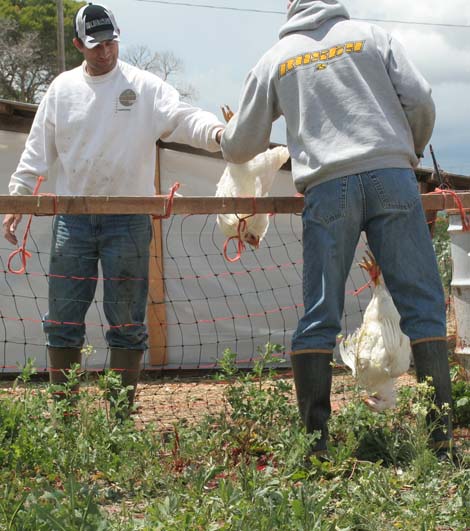
First, the boys hung the chickens upside down by their (the chickens’) legs.

Then they made a shallow cut. Just enough to slice the artery.
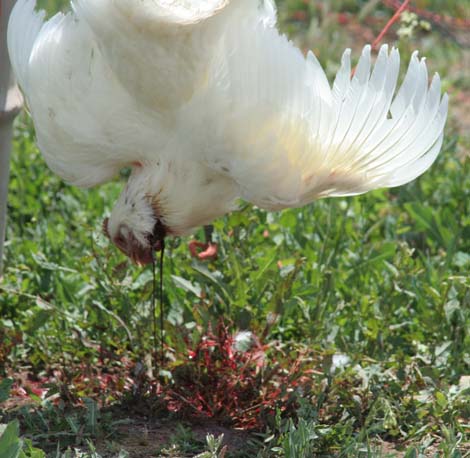
When the chicken loses blood this quickly, it goes to sleep until it bleeds out and dies. It is painless for the chicken. It doesn’t even flap its wings, it just goes to sleep. As a person who has lost A LOT of blood in a short period of time, I can testify that this is a painless way to go. Honestly, all I wanted to do was close my eyes and sleep. The effort of keeping my eyelids open was even too much. Thank goodness for a sister in-law and husband who picked me up off the floor and took me to the hospital where they stuck an IV in me to get by blood volume up to an acceptable level and then gave me a blood transfusion in the middle of the night because I wasn’t doing so well. No one but me knew how much blood I’d actually lost, and I wasn’t exactly coherent. Whenever I tried to talk to my husband and father in-law they would just look at me and then go back to talking to each other. I later learned I was only making gibberish sounds, not words. So if you can’t keep your eyelids open, it’s a pretty safe bet you can’t form intelligible words.
Anyway, back to the chickens. So it’s painless. Take my word for it.

Transport vehicle.
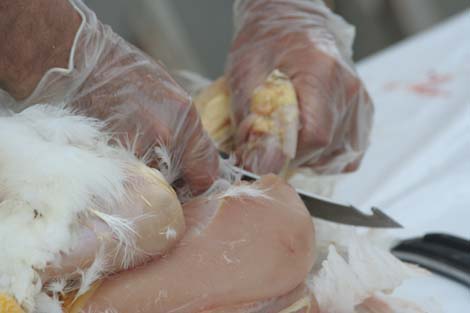
This is the skinning process. No boiling water and plucking feathers here.

Gizzards, hearts, and other stuff anyone?

This is starting to look familiar.

Ice, water and clorox. Sometimes when you run to the store to buy ice, the set up for this procedure isn’t exactly where the woman of the house would have chosen, as you will see.

Now the chickens get a cold shower before their ice bath. Yeah, that’s my backyard. The lawn. The children’s toys. I love disinfectant.
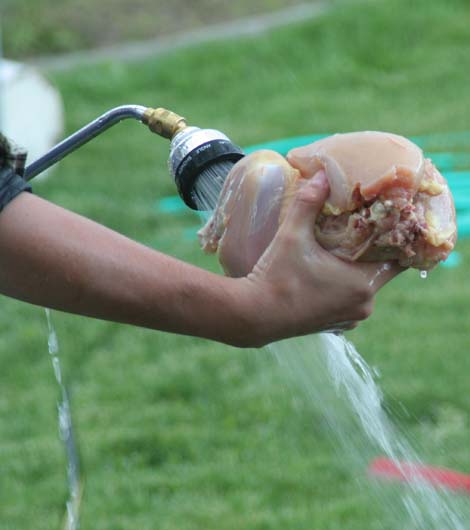
Gotta wash inside, too. (Special thanks to Matt’s two nephews who were visiting and got roped into this.)
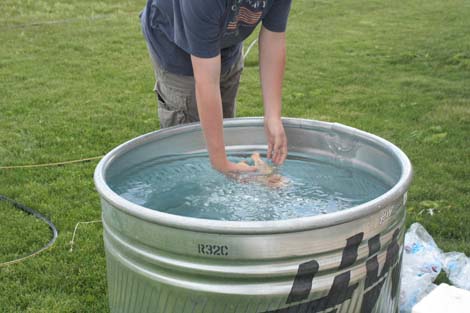
Next they slide into an ice cold bath.
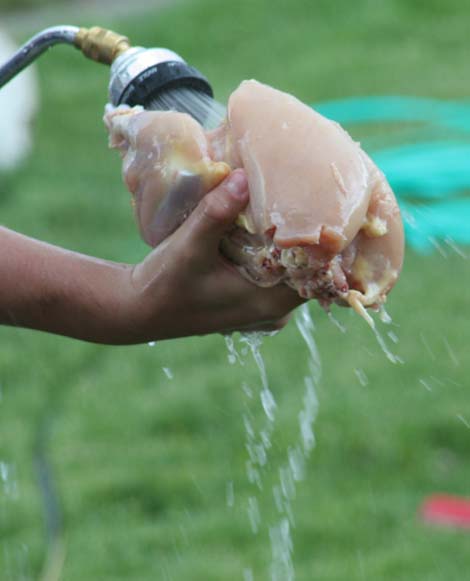
After all the chickens are in the tub, each gets a final shower before…

being placed in a freezer bag.

Next stop the freezer. And our table sometime in the future.
And so we see that Nate was right. He’s always right. When will I ever learn?
(By the way, no black hens were harmed in the production of this tutorial. They’re our layers and have a long life ahead–as long as they produce eggs.)




Holy cow. I mean . . . oh, never mind. This is very interesting. My friend is big on chickens. May I refer her to this post? (She runs a blog, http://www.backyardfarming.blogspot.com and may even be interested having you as a guest contributor on the subject, if you’re game.)
When did you have such a scary bleeding episode? Despite knowing you’re now safe, it gave me shivers just reading about it. Take care.
I’ve visited that blog via your blog before. It’s very informative. I loved your seed rack contribution. If I had a little more ambition, I would have tried it this year. Nate really wants one. You may refer her to this post, no problem. I’ll email you about the bleeding incident…long story for a comments section. Thanks for sharing your wit here. I so enjoy reading your words.
Wow, that’s crazy! That’s one of those tasks that I’m so grateful someone is willing to do, because I don’t think I could stomach it!
Fascinating process, though.
– Chas